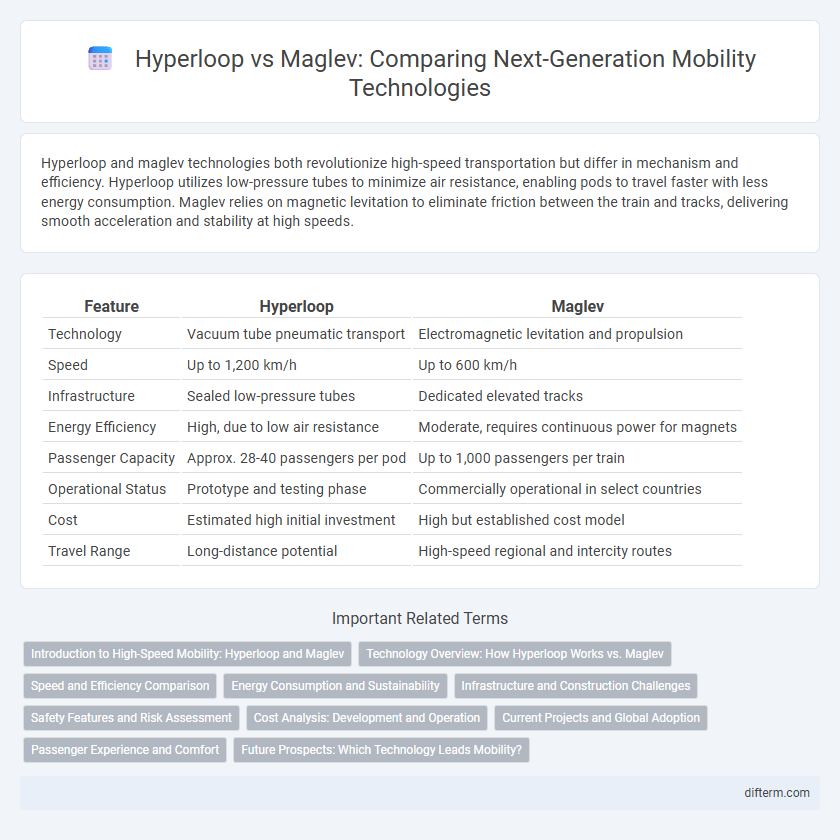Hyperloop and maglev technologies both revolutionize high-speed transportation but differ in mechanism and efficiency. Hyperloop utilizes low-pressure tubes to minimize air resistance, enabling pods to travel faster with less energy consumption. Maglev relies on magnetic levitation to eliminate friction between the train and tracks, delivering smooth acceleration and stability at high speeds.
Table of Comparison
| Feature | Hyperloop | Maglev |
|---|---|---|
| Technology | Vacuum tube pneumatic transport | Electromagnetic levitation and propulsion |
| Speed | Up to 1,200 km/h | Up to 600 km/h |
| Infrastructure | Sealed low-pressure tubes | Dedicated elevated tracks |
| Energy Efficiency | High, due to low air resistance | Moderate, requires continuous power for magnets |
| Passenger Capacity | Approx. 28-40 passengers per pod | Up to 1,000 passengers per train |
| Operational Status | Prototype and testing phase | Commercially operational in select countries |
| Cost | Estimated high initial investment | High but established cost model |
| Travel Range | Long-distance potential | High-speed regional and intercity routes |
Introduction to High-Speed Mobility: Hyperloop and Maglev
High-speed mobility technologies such as Hyperloop and Maglev revolutionize transportation by drastically reducing travel times and enhancing efficiency. Hyperloop uses low-pressure tubes to propel pods at speeds exceeding 700 mph, minimizing air resistance for rapid transit. Maglev employs magnetic levitation to eliminate friction, enabling trains to reach speeds up to 375 mph with smooth and quiet operation.
Technology Overview: How Hyperloop Works vs. Maglev
The Hyperloop utilizes low-pressure tubes to reduce air resistance, propelling pods through magnetic levitation and linear induction motors for high-speed, energy-efficient travel. Maglev trains rely exclusively on magnetic levitation to lift and accelerate the train along a guideway, minimizing friction for smooth and rapid transit. While both technologies leverage magnetic forces, Hyperloop's vacuum-sealed environment offers the potential for higher speeds and reduced aerodynamic drag compared to traditional maglev systems.
Speed and Efficiency Comparison
Hyperloop systems achieve speeds up to 760 mph by utilizing low-pressure tubes to minimize air resistance, surpassing traditional maglev trains that max out around 375 mph with magnetic levitation reducing friction. Hyperloop's near-vacuum environment enables higher energy efficiency per passenger mile, whereas maglev trains, although highly efficient due to magnetic propulsion, face aerodynamic drag at higher speeds. Both technologies promise revolutionary transit improvements, but hyperloop's speed and energy profile suggest greater potential for ultra-fast, sustainable long-distance travel.
Energy Consumption and Sustainability
Hyperloop systems consume significantly less energy compared to maglev trains due to reduced air resistance and friction in their near-vacuum tubes, enhancing energy efficiency. Maglev technology relies on complex electromagnetic systems that demand continuous high power input, impacting overall sustainability. The lower operational energy and potential integration with renewable energy sources make hyperloop a more sustainable alternative for future high-speed transport.
Infrastructure and Construction Challenges
Hyperloop infrastructure demands extensive vacuum-sealed tubes and airtight stations, posing significant engineering challenges in terrain adaptation and long-distance maintenance. Maglev requires precise electromagnetic track alignment and powerful linear motors embedded in guideways, resulting in complex and costly construction processes. Both systems face difficulties with land acquisition and integration into existing urban transportation networks.
Safety Features and Risk Assessment
Hyperloop systems incorporate enclosed tracks that mitigate external interference and reduce collision risks, enhancing overall passenger safety compared to maglev trains. Maglev technology benefits from well-established electromagnetic levitation and braking mechanisms that provide stable and reliable operations with extensive safety records. Risk assessment for hyperloop prioritizes air pressure maintenance and emergency evacuation protocols, while maglev focuses on electromagnetic system redundancies and track integrity monitoring.
Cost Analysis: Development and Operation
The cost analysis of hyperloop versus maglev reveals that hyperloop systems have lower initial infrastructure expenses due to reduced land acquisition and simpler tube construction, while maglev requires extensive electromagnetic tracks with higher material costs. Operational costs favor hyperloop because of its energy-efficient vacuum environment, which minimizes air resistance, leading to lower power consumption compared to maglev's continuous electromagnetic propulsion. Long-term maintenance expenses tend to be higher for maglev due to complex track components, whereas hyperloop's sealed environment reduces wear and tear, potentially offering more cost-effective scalability.
Current Projects and Global Adoption
Hyperloop and maglev technologies are advancing with prominent projects like Virgin Hyperloop's test track in Nevada and Japan's SCMaglev nearing commercial operation between Tokyo and Nagoya. Global adoption sees China leading maglev deployments with multiple urban lines, while the United States and Middle Eastern countries invest in hyperloop feasibility studies and pilot routes. These transportation solutions aim to revolutionize high-speed travel by combining reduced travel time with sustainability goals worldwide.
Passenger Experience and Comfort
Hyperloop systems offer a cushioned, pressurized cabin environment that minimizes noise and vibrations, enhancing passenger comfort during ultra-high-speed travel. Maglev trains provide a smooth, stable ride with superior acceleration and deceleration control, reducing motion sickness and ensuring a quiet journey. Differences in seating design and space utilization between hyperloop pods and maglev carriages also significantly influence the overall passenger experience.
Future Prospects: Which Technology Leads Mobility?
Hyperloop technology promises unparalleled speeds exceeding 700 mph through near-vacuum tubes, offering revolutionary long-distance travel with minimal energy consumption and environmental impact. Maglev trains, currently operational in several countries, provide high-speed, reliable urban and regional transit with speeds up to 375 mph and mature infrastructure support. Future mobility likely favors hyperloop for intercity rapid transit due to groundbreaking speed and efficiency, while maglev maintains dominance in established high-speed rail corridors and urban connections.
hyperloop vs maglev Infographic

 difterm.com
difterm.com